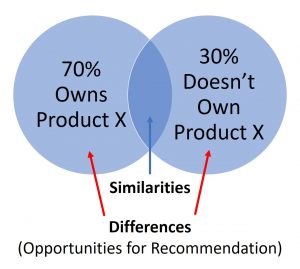 If you’ve ever used Amazon or Netflix, you’ve experienced the value of recommendation systems firsthand. These sophisticated systems identify recommendations autonomously for individual users based on past purchases and searches, as well as other behaviors. Customers get algorithmic recommendations on additional offerings that are intended to be relevant, valued, and helpful. Consumers can use recommendation to:
If you’ve ever used Amazon or Netflix, you’ve experienced the value of recommendation systems firsthand. These sophisticated systems identify recommendations autonomously for individual users based on past purchases and searches, as well as other behaviors. Customers get algorithmic recommendations on additional offerings that are intended to be relevant, valued, and helpful. Consumers can use recommendation to:
- Find things that are interesting or useful.
- Narrow a set of choices.
- Explore options.
- Discover new things.
Marketers can enhance offers that proactively build better customer relationships, retention and sales. For example, organizations typically realize:
- Stronger customer relationships by providing personalization.
- Higher engagement, click-through and conversion rates.
- New opportunities for promotion, persuasion, and profitability.
- Deeper knowledge about customers.
User-centric vs. Item-centric Filtering
Marketers can use two algorithmic approaches to recommendations.
User-centric collaborative filtering is a very popular way of recommending products or content. It involves finding general similarities in behavior or characteristics between users, then identifying specific differences between those linked users makes the case for sales opportunities.
For example, you might identify a group of customers who have purchased a common set of offerings. If 70 percent of a segment also have Product X, then you have a potential cross sell item for the 30 percent that have not bought it. The strength of the prediction for X (the filtering part) to a user depends on how similar that user is in behavior to others in the group (the collaborative part).
Item-centric (or content-based) filtering is used to recommend other products based on associations. This is helpful when you don’t know anything about the user other than they are interested in a product in their current website visit. Product X is associated with Products Y and Z. A popular example of this approach is called association rule learning, which is a rule-based machine learning method for discovering relationships between variables. The association method is intended to identify strong rules discovered in data using measures of interestingness (support, confidence, and lift).
For example, the rule: {Cavaliers, Warriors} → {Wizards} found in the ticketing sales data of a NBA professional basketball organization generates a lift value of 3, indicating that if a fan has purchased tickets to see their local team play the Cavaliers and Warriors, they are three times as likely to have also bought a ticket to see the Wizards. Such information can be used as the basis for decisions about digital marketing activities such as promotional pricing, or targeted product recommendations.
Measuring Product Interest In SAS Customer Intelligence 360
Recommendation systems require more than just building statistical models. Your marketing system needs to:
- Collect data about users, items and profiles.
- Prepare, aggregate and filter data for specific types of algorithms.
- Run algorithms and produce actionable scoring.
- Deliver personalized recommendations.
Before you do any analysis, you need data. To enable an algorithmic recommendation model from a user's behavior, a distinction is often made between explicit and implicit forms of data collection.
Examples of explicit data collection include Asking a user to:
- Rate an item on a sliding scale.
- Search for terms or brands.
- Rank a collection of items from favorite to least favorite.
Examples of implicit data collection include:
- Observing the items that a user views on a website or app.
- Analyzing item/user viewing times.
- Keeping a record of the items that a user purchases.
SAS Customer Intelligence 360 currently supports implicit data collection methods to capture a user’s interest in a specific product, offering, or piece of content. The simplest method is to measure whether a user views a product, and how many times. This is aggregated across website visits and/or app sessions. For each user and product, we end up with a count.
In reality data is often highly skewed, with many visitors who viewed one product, or none. Plus, brands with multiple offerings may find that numerous products are never viewed. This is an example of the sparsity problem, and even the most active users of a website or app will have only viewed a small subset of the overall offerings.
Even the most popular items may have few views. That leads to a sparse users-items representation matrix and, therefore, inability to locate neighbors (lookalikes) or derive common behavior patterns, and the result is low-quality recommendations.
These challenges led SAS to refine the methods used in Customer Intelligence 360 to create the input data used to train our algorithmic recommendation system.
A significant differentiator is the analytics lifecycle: only by recognizing and fully supporting the phases around data, discovery and deployment will you get a complete process to take advantage of impactful insights. Everything SAS does is built around the need to get from data to value, with the analytics lifecycle as the underlying principle. We have it down to a science, and algorithmic recommendations is one of many customer personalization challenges currently supported.
SAS Customer Intelligence 360 uses two algorithmic techniques in a hybrid approach to deliver recommendations. Research has demonstrated that a hybrid approach, combining collaborative filtering and content-based (item) filtering is more effective, while providing a solution to overcome recommendation system challenges common in digital marketing, such as the scalability, sparsity and cold-start problems.
Business Use Case Considerations
Our customers have specific needs when it comes to recommendation systems. It’s not as simple as “Give me the top ‘N’ products for a user”. Is the intention to, for example:
- Provide alternative products within a category – offer high fidelity headphone offerings from competitive brands to the one being viewed?
- Upsell within a category – offer high-fidelity headphones when a user is looking at low-fidelity options?
- Cross-sell between categories – offer a wireless audio speaker to a user looking at high-fidelity headphones?
Each of these requires a slightly different approach to pre-and post-processing of data. In addition, each use case fits a different part of a website or app experience. Then there are questions about what to do if a product is unavailable. Being able to work with s is important for inclusion and exclusion rules. A frequent use case for a black list is to prevent out-of-stock products from being recommended. SAS provides an API for uploading white and black lists in Customer Intelligence 360.
Takeaways
SAS’s vision is to help digital marketers be effective through analytic techniques. Consumer preferences are hard to predict. By using SAS’s deep library of algorithms, recommendations can automatically shapeshift to meet the demands of the consumer, and create brand relevancy through data-driven personalization.
In Part 2 of this blog posting series, we will dive into specific detail within these areas, as well as show how users can set up an automated recommendation system within SAS Customer Intelligence 360.
This blog post was authored by Malcolm Lightbody (SAS Customer Intelligence Product Management) and Suneel Grover (SAS Principal Solutions Architect).




1 Comment
Pingback: SAS Customer Intelligence 360: Factorization machines, visual analytics, and personalized marketing (Part 1) - Customer Intelligence Blog